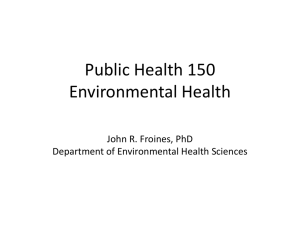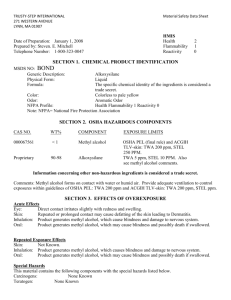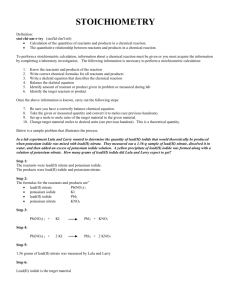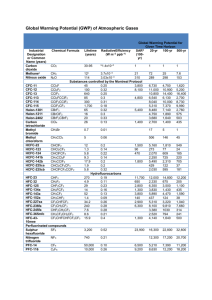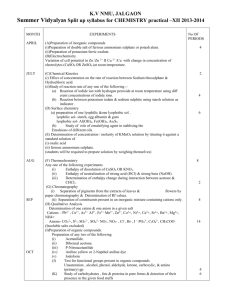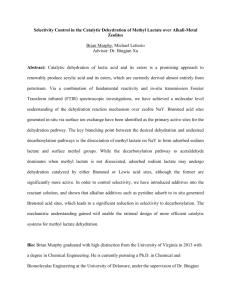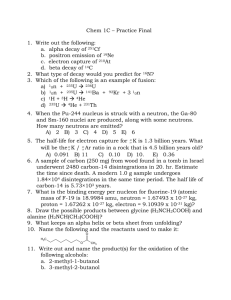Chamberland SOP Working with Methyl Iodide
advertisement
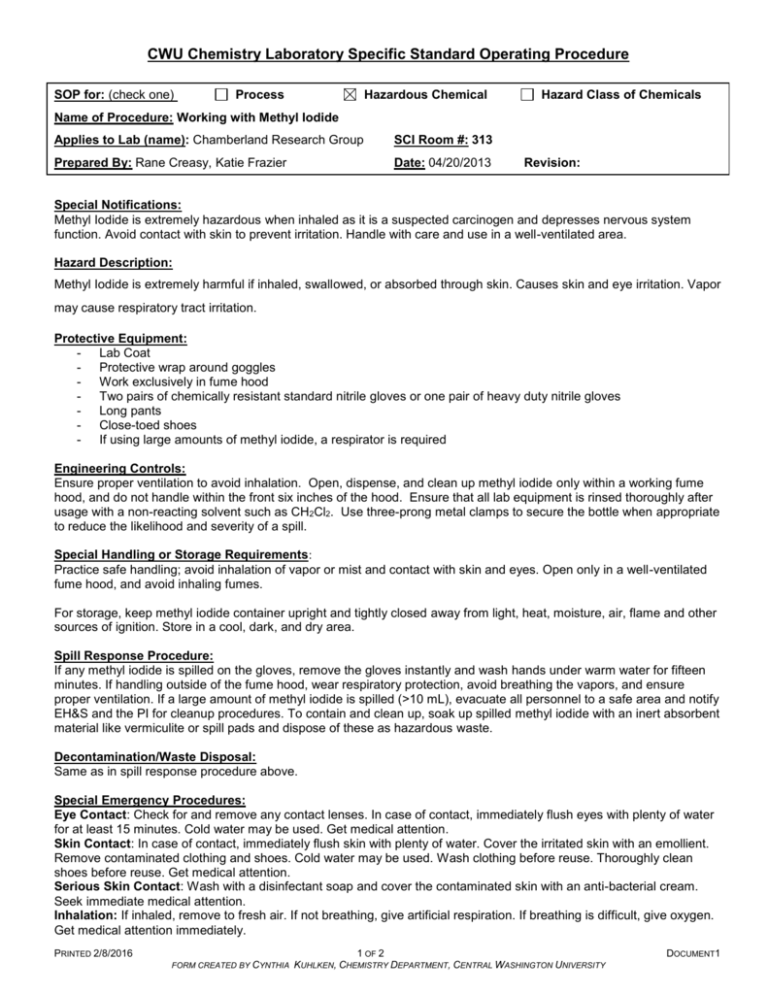
CWU Chemistry Laboratory Specific Standard Operating Procedure SOP for: (check one) Process Hazardous Chemical Hazard Class of Chemicals Name of Procedure: Working with Methyl Iodide Applies to Lab (name): Chamberland Research Group SCI Room #: 313 Prepared By: Rane Creasy, Katie Frazier Date: 04/20/2013 Revision: Special Notifications: Methyl Iodide is extremely hazardous when inhaled as it is a suspected carcinogen and depresses nervous system function. Avoid contact with skin to prevent irritation. Handle with care and use in a well-ventilated area. Hazard Description: Methyl Iodide is extremely harmful if inhaled, swallowed, or absorbed through skin. Causes skin and eye irritation. Vapor may cause respiratory tract irritation. Protective Equipment: - Lab Coat - Protective wrap around goggles - Work exclusively in fume hood - Two pairs of chemically resistant standard nitrile gloves or one pair of heavy duty nitrile gloves - Long pants - Close-toed shoes - If using large amounts of methyl iodide, a respirator is required Engineering Controls: Ensure proper ventilation to avoid inhalation. Open, dispense, and clean up methyl iodide only within a working fume hood, and do not handle within the front six inches of the hood. Ensure that all lab equipment is rinsed thoroughly after usage with a non-reacting solvent such as CH2Cl2. Use three-prong metal clamps to secure the bottle when appropriate to reduce the likelihood and severity of a spill. Special Handling or Storage Requirements: Practice safe handling; avoid inhalation of vapor or mist and contact with skin and eyes. Open only in a well-ventilated fume hood, and avoid inhaling fumes. For storage, keep methyl iodide container upright and tightly closed away from light, heat, moisture, air, flame and other sources of ignition. Store in a cool, dark, and dry area. Spill Response Procedure: If any methyl iodide is spilled on the gloves, remove the gloves instantly and wash hands under warm water for fifteen minutes. If handling outside of the fume hood, wear respiratory protection, avoid breathing the vapors, and ensure proper ventilation. If a large amount of methyl iodide is spilled (>10 mL), evacuate all personnel to a safe area and notify EH&S and the PI for cleanup procedures. To contain and clean up, soak up spilled methyl iodide with an inert absorbent material like vermiculite or spill pads and dispose of these as hazardous waste. Decontamination/Waste Disposal: Same as in spill response procedure above. Special Emergency Procedures: Eye Contact: Check for and remove any contact lenses. In case of contact, immediately flush eyes with plenty of water for at least 15 minutes. Cold water may be used. Get medical attention. Skin Contact: In case of contact, immediately flush skin with plenty of water. Cover the irritated skin with an emollient. Remove contaminated clothing and shoes. Cold water may be used. Wash clothing before reuse. Thoroughly clean shoes before reuse. Get medical attention. Serious Skin Contact: Wash with a disinfectant soap and cover the contaminated skin with an anti-bacterial cream. Seek immediate medical attention. Inhalation: If inhaled, remove to fresh air. If not breathing, give artificial respiration. If breathing is difficult, give oxygen. Get medical attention immediately. PRINTED 2/8/2016 FORM CREATED BY CYNTHIA 1 OF 2 KUHLKEN, CHEMISTRY DEPARTMENT, CENTRAL WASHINGTON UNIVERSITY DOCUMENT1 CWU Chemistry Laboratory Specific Standard Operating Procedure Serious Inhalation: Evacuate the victim to a safe area as soon as possible. Loosen tight clothing such as a collar, tie, belt or waistband. If breathing is difficult, administer oxygen. If the victim is not breathing, perform mouth-to-mouth resuscitation. It may be hazardous to the person providing aid to give mouth-to-mouth resuscitation when the inhaled material is toxic, infectious or corrosive. Seek immediate medical attention. Ingestion: If swallowed, do not induce vomiting unless directed to do so by medical personnel. Never give anything by mouth to an unconscious person. Loosen tight clothing such as a collar, tie, belt or waistband. Get medical attention immediately. Procedure may be performed after normal working hours (M-F, 8-5)? Procedure may be left unattended? Yes Yes No No Step by Step Procedure: 1. Ensure that the reaction flask(s) and all other required equipment are prepared prior to using methyl iodide. 2. Ready a small Erlenmeyer flask or beaker with about 5 mL of CH2Cl2 to dilute and rinse methyl iodide from all measuring devices. Also have a plastic squirt bottle of CH 2Cl2 nearby as well as a saturated aqueous solution of 4.5 M KOH in ethanol to neutralize spilled or unreacted methyl iodide. 3. Remove the methyl iodide from the freezer and place it in the fume hood. 4. Remove the parafilm and cap from the bottle of methyl iodide. Keep the methyl iodide in the fume hood at all times. 5. Using a glass syringe with metal needle; obtain the required volume of methyl iodide. If drawing out methyl iodide with a syringe, do so carefully. See the SOP Using a syringe, if questions arise. Add methyl iodide dropwise to the reaction flask. 6. Wash the syringe and needle by rinsing it several times with CH 2Cl2. Dispose of these rinses in the halogenated organic waste container. 7. Cap and parafilm the bottle of methyl iodide, then put it back into the freezer immediately after use. 8. Clean the syringe and needle immediately to reduce the chance for corrosion. Approved By (PI) : Stephen Chamberland, Ph.D. Date: 5-3-13 PI Signature: __________________________________________________ EH&S Signature: ________________________________________________ PRINTED 2/8/2016 FORM CREATED BY CYNTHIA Date: ______________ 2 OF 2 KUHLKEN, CHEMISTRY DEPARTMENT, CENTRAL WASHINGTON UNIVERSITY DOCUMENT1
